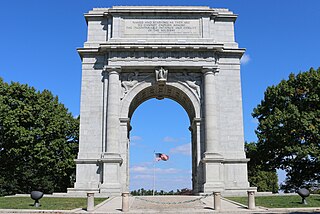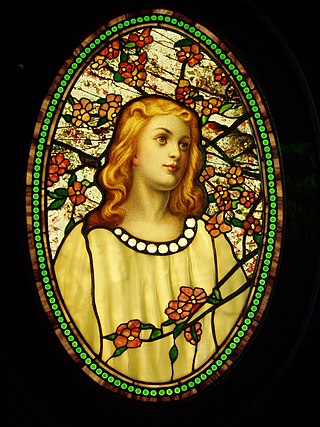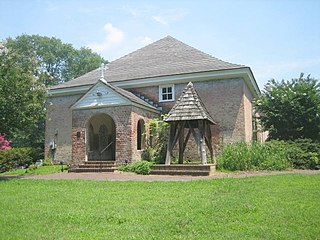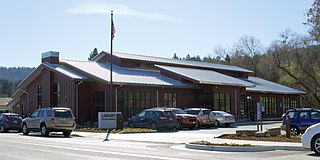
Boulder Creek is a small rural mountain community in the coastal Santa Cruz Mountains. It is a census-designated place (CDP) in Santa Cruz County, California, with a population of 5,429 as of the 2020 census. Throughout its history, Boulder Creek has been home to a logging town and a resort community, as well as a counter-culture haven. Today, it is identified as the gateway to Big Basin Redwoods State Park.

Wappingers Falls is a village in the towns of Poughkeepsie and Wappinger, in Dutchess County, New York, United States. As of the 2010 census it had a population of 5,522. The community was named for the cascade in Wappinger Creek. The Wappingers Falls post office covers areas in the towns of Wappinger, Poughkeepsie, Fishkill, East Fishkill, and LaGrange. This can result in some confusion when residents of the outlying towns, who do not live in the village, give their address as "Wappingers Falls".

Ralph Adams Cram was a prolific and influential American architect of collegiate and ecclesiastical buildings, often in the Gothic Revival style. Cram & Ferguson and Cram, Goodhue & Ferguson are partnerships in which he worked. Cram was a fellow of the American Institute of Architects.

James Renwick Jr. was an American architect in the 19th century, noted especially for designing churches and museums. The Encyclopedia of American Architecture calls him "one of the most successful American architects of his time".

Valley Forge National Historical Park is the site of the third winter encampment of the Continental Army during the American Revolutionary War from December 19, 1777 to June 19, 1778. The National Park Service preserves the site and interprets the history of the Valley Forge encampment. The park contains historical buildings, recreated encampment structures, memorials, museums, and recreation facilities.

Carpenter Gothic, also sometimes called Carpenter's Gothic or Rural Gothic, is a North American architectural style-designation for an application of Gothic Revival architectural detailing and picturesque massing applied to wooden structures built by house-carpenters. The abundance of North American timber and the carpenter-built vernacular architectures based upon it made a picturesque improvisation upon Gothic a natural evolution. Carpenter Gothic improvises upon features that were carved in stone in authentic Gothic architecture, whether original or in more scholarly revival styles; however, in the absence of the restraining influence of genuine Gothic structures, the style was freed to improvise and emphasize charm and quaintness rather than fidelity to received models. The genre received its impetus from the publication by Alexander Jackson Davis of Rural Residences and from detailed plans and elevations in publications by Andrew Jackson Downing.

Darlington is an unincorporated community and census-designated place in northeastern Harford County, Maryland, United States. The population was 409 at the 2010 census. The center of the community was listed on the National Register of Historic Places as the Darlington Historic District in 1987. Median household income is $66,563. The percentage of people in poverty is 5.3%.

Tiffany glass refers to the many and varied types of glass developed and produced from 1878 to 1933 at the Tiffany Studios in New York City, by Louis Comfort Tiffany and a team of other designers, including Clara Driscoll, Agnes F. Northrop, and Frederick Wilson.

Roosevelt Organ Works was an American manufacturer of pipe organs. It was founded by Hilborne Roosevelt (1849–1886) and his younger brother, Frank Roosevelt (1862–1895), in 1872. It operated in New York City, with branches in Baltimore and Philadelphia. The brothers built some of the largest organs in the United States during their career, and many today are still prized for their quality and tone. The company was in operation until 1893.

St. John's Church, St. John's Episcopal Church, or St. John's Episcopal Church, Broad Creek, is a historic Episcopal church located at 9801 Livingston Road in Fort Washington, Prince George's County, Maryland. It is a rectangular Flemish bond brick structure with a bell hipped roof. The interior features a barrel vaulted ceiling with an intricate support system.

The Evans Memorial Chapel is an historic chapel on the campus of the University of Denver in Colorado. It is the oldest continuously-used building for religious purposes in Denver. Completed in 1878, the Evans Memorial Chapel was built with patronage by John Evans in honor of his daughter Josephine. Evans was governor of the Colorado Territory and a founder of the Colorado Seminary. Once part of Grace Church, a prominent Methodist Episcopal congregation on 13th Avenue and Bannock in downtown Denver, the small Gothic Revival chapel was moved to the University of Denver's campus in 1959. It reopened there in April 1960, and is now the campus's oldest building. It currently serves as an interdenominational chapel and wedding venue.

The Oak Hill Cemetery Chapel, also known as the Renwick Chapel or James Renwick Chapel, is a historic building in the Georgetown neighborhood of Washington, D.C., United States. Designed by James Renwick, Jr. in 1850, Oak Hill Cemetery Chapel is the architect's only known example of Gothic Revival church architecture in Washington, D.C. It is located on the highest ridge in Oak Hill Cemetery, near the intersection of 29th and R Streets NW. The chapel is one of two structures in Oak Hill Cemetery listed on the National Register of Historic Places, the other being the Van Ness Mausoleum. The chapel, mausoleum, and cemetery are contributing properties to the Georgetown Historic District, a National Historic Landmark.

Jacksonville Historical Society (JHS) is a 501(c)(3) non-profit organization in Jacksonville, Florida, begun by 231 charter members on May 3, 1929 at the Carling Hotel.

Valley Creek Presbyterian Church is a historic Presbyterian church in Valley Grande, Alabama, United States. The two-story red brick church building was built in the Greek Revival-style from 1857–1859. The sanctuary and a mezzanine level, formerly a slave gallery, are located on the upper floor. It was added to the National Register of Historic Places on May 28, 1976, due to its architectural significance.

The Felton Presbyterian Church (Historical Building) is a former public library and church building in Felton, California. It was located in a historic building at 6299 Gushee Street, built in 1893, known formerly as Felton Presbyterian Church. The building is listed on the National Register of Historic Places under its former name.
The Civil War Trust's Civil War Discovery Trail is a heritage tourism program that links more than 600 U.S. Civil War sites in more than 30 states. The program is one of the White House Millennium Council's sixteen flagship National Millennium Trails. Sites on the trail include battlefields, museums, historic sites, forts and cemeteries.

The Felton Public Library serves the residents of San Lorenzo Valley in Santa Cruz County, California in the United States. Its 8,900-square-foot (830 m2) building is located next to the post office, at 6121 Gushee St. The 2-acre (8,100 m2) Felton Discovery Park extends out from its doors.



















